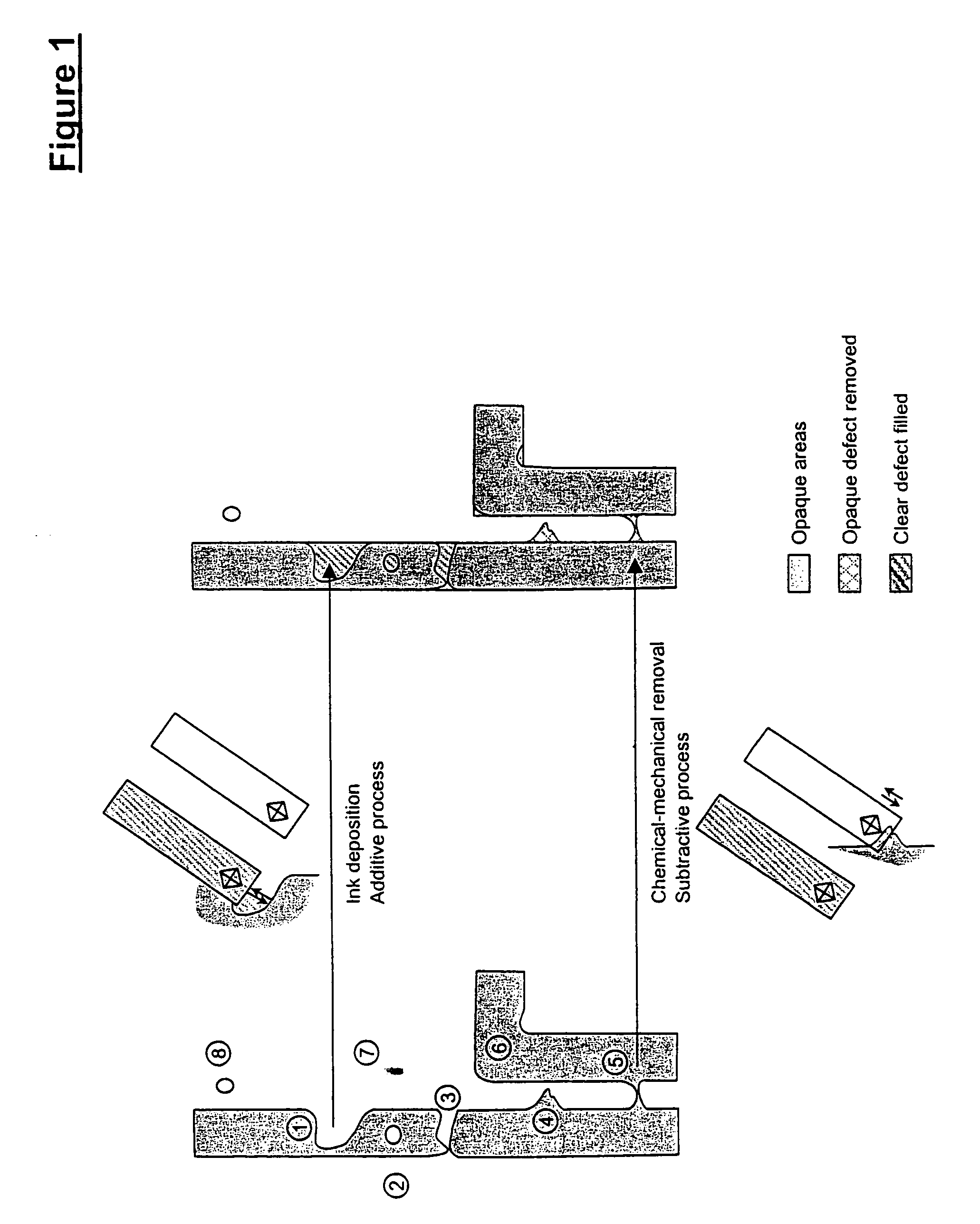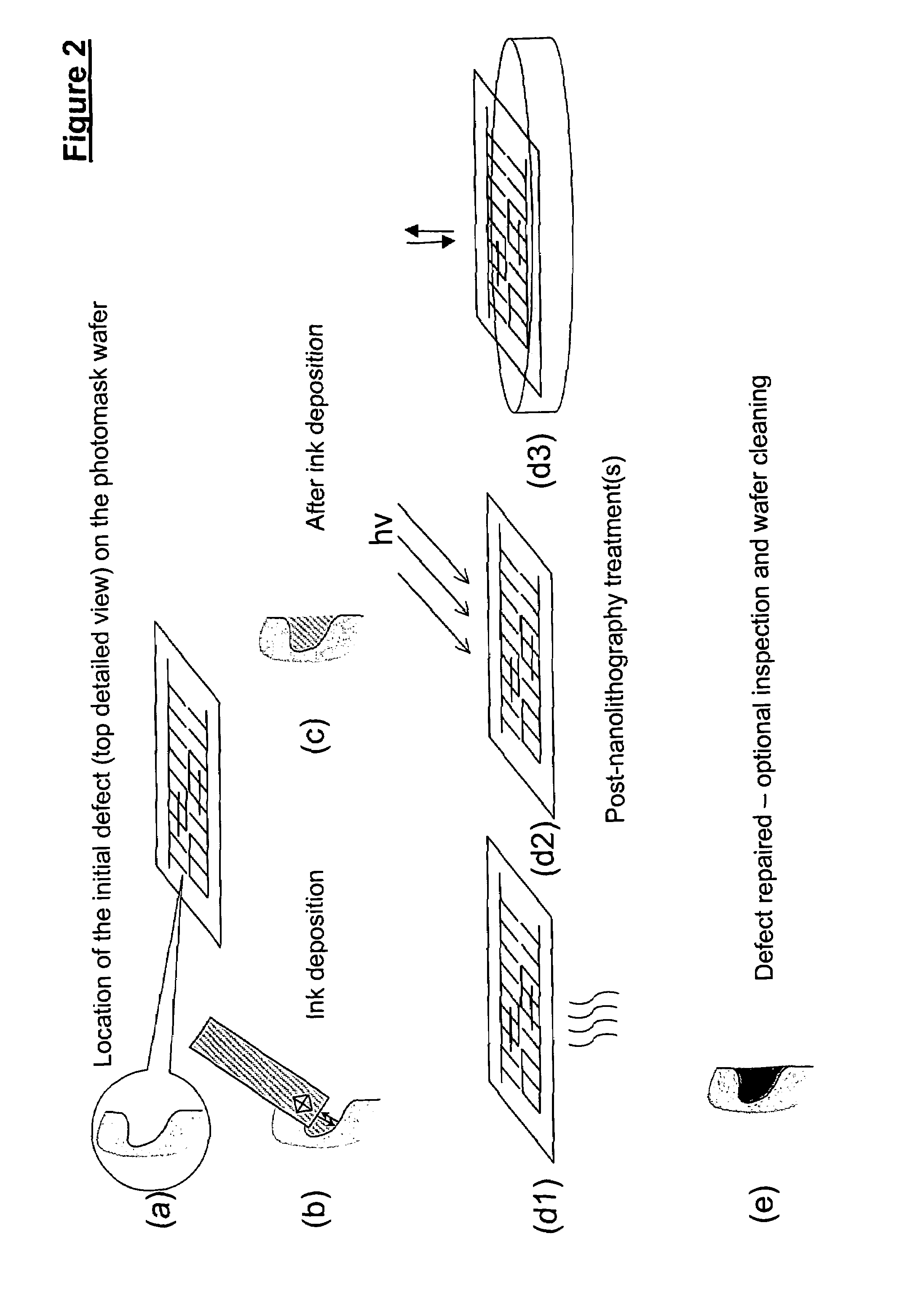Methods for additive repair of phase shift masks by selectively depositing nanometer-scale engineered structures on defective phase shifters
a phase shifter and additive technology, applied in the field of engineering of nanometer-scale structures, can solve the problems of inability to remove hard defects by cleaning process, high cost and complexity of photomasks, and achieve the effect of enhancing the mask
- Summary
- Abstract
- Description
- Claims
- Application Information
AI Technical Summary
Benefits of technology
Problems solved by technology
Method used
Image
Examples
example 1
[0168]A polymer or polymer precursor is deposited and air-dried or air-cured. To obtain optically adequate (i.e. opaque) deposits, the curable polymer / precursor may be mixed with a colloidal solution, esp. metallic or metal oxide nanoparticles. Commercially available inks include water-, methylisobutyl ketone or isopropanol-based silver and carbon nanoparticle paints, such as these commercialized by Ted Pella, Inc.
example 2
[0169]A priming layer, such as ω-functionalized self-assembled monolayer (e.g. trialkoxy- or trichlorosilanes on quartz, alkanethiols on coinage metals) is deposited on the substrate. The ω-terminal functional group (e.g. —SH, —COOH, —CHO . . . ) is selected as a function of the subsequent inks to deposit. For example, ligand-protected metallic colloids (gold, silver) may adhere by place-exchange between the ligand and the layer terminal group, and by electrostatic interaction. In another example, a (e.g., amine-rich or carboxylic acid-rich) polyelectrolyte is deposited that has an opposite charge to that of the ω-terminal group. Charged colloidal particles may then be deposited to form an electrostatic sandwich, as described by Chen et al [K. M. Chen, X. Jiang, L. C. Kimerling and P. T. Hammond, “Selective Self Organization of Colloids on Patterned Polyelectrolyte Templates”, Langmuir, 16, 7825-7834 (2000).] and by Wuelfing et al (Chem. Mater. 2001, 13, 87-95)
Part 2
Deposition and A...
example 3
Metal Deposition and Chemical Reduction
[0171]Palladium chloride (PdCl2) or acetate was deposited from an aqueous solution by DPN™ printing or deposition in the area to fill with metal. The palladium salt structures were reduced to the metallic state, Pd0, by deposition of a reducing agent (e.g. stannous chloride (SnCl2), aqueous dimethylamine-borane, dimethylsulfide:borane, or sodium borohydride) by DPN™ printing or deposition, or flooding, or immersion of the substrate in a bath containing a solution of the reducing agent. This procedure may also be used to deposit other metals, such as silver, copper, iron, platinum, gold, and cobalt when the appropriate metal salt is chosen as an ink.
[0172]FIG. 10. (Working Example) AFM images before and after the reduction reaction are shown in FIG. 10. Deposition of disodium palladium chloride (1 mg / μL in water) with 10% polyethyleneoxide (MW 10,000) via DPN™ printing on amino-silanized glass (Schott Glass company), and subsequent chemical redu...
PUM
| Property | Measurement | Unit |
|---|---|---|
| height | aaaaa | aaaaa |
| height | aaaaa | aaaaa |
| height | aaaaa | aaaaa |
Abstract
Description
Claims
Application Information
 Login to View More
Login to View More - R&D
- Intellectual Property
- Life Sciences
- Materials
- Tech Scout
- Unparalleled Data Quality
- Higher Quality Content
- 60% Fewer Hallucinations
Browse by: Latest US Patents, China's latest patents, Technical Efficacy Thesaurus, Application Domain, Technology Topic, Popular Technical Reports.
© 2025 PatSnap. All rights reserved.Legal|Privacy policy|Modern Slavery Act Transparency Statement|Sitemap|About US| Contact US: help@patsnap.com



